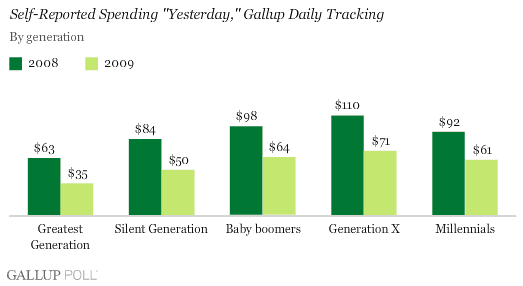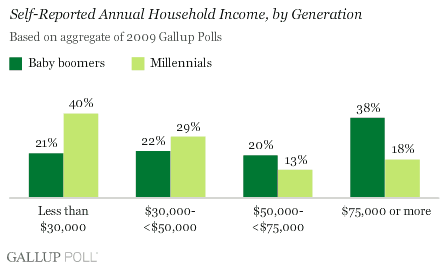PRINCETON, NJ -- Baby boomers' self-reported average daily spending of $64 in 2009 is down sharply from an average of $98 in 2008. But baby boomers -- the largest generational group of Americans -- are not alone in pulling back on their consumption, as all generations show significant declines from last year. Generation X has reported the greatest spending on average in both years, and is averaging $71 per day so far in 2009, down from $110 in 2008.

According to Gallup's estimates, 36% of U.S. adults are part of the baby boom generation (born between 1946 and 1964), making it easily the largest of the five most commonly defined generations. At 24%, Generation X is the next largest.

With baby boomers constituting the largest bloc of U.S. consumers, their spending habits have a proportionately greater effect on the economy, given that consumer spending accounts for about two-thirds of the total gross domestic product.
Some experts attribute the sustained economic growth of the 1980s and 1990s to the fact that baby boomers reached their peak earning (and spending) years during this time. As they now near retirement age, the concern is that baby boomers will pull back on spending to make up for the losses suffered in their retirement savings over the past year, hindering an economic recovery.
Data from Gallup's Daily tracking survey -- which asks U.S. consumers to report how much they spent "yesterday," excluding normal household bills and major purchases such as homes and cars -- suggest boomers have already pulled back significantly this year from their reported average spending levels in 2008 (the Gallup Daily survey began in 2008, so data from prior years are not available).
But the fact that all American generations seem to be pulling back sharply on spending -- even as optimism about the future of the U.S. economy has increased -- does not bode well for a strong economic recovery in the near term.
While baby boomers' sheer numbers make their influence on the national economy greater than that of any other generation, their average reported spending is actually lower than that of Generation X. In 2009, average reported daily spending among Gen X'ers is $71, while it is $64 among baby boomers. Last year, the figures were $110 and $98, respectively. Higher spending among Generation X is not a function of greater income, as the two groups have similar income distributions.

The most likely reason for the difference is that 71% of Gen X'ers have children under 18, according to Gallup estimates. Gallup has found the presence of young children in the household to be a major predictor of reported spending (in 2008 and 2009, the difference in reported average spending between parents with children under age 18 and non-parents was about $20). By comparison, only about one in four baby boomers have children under age 18.
Also notable in the data is the fact that reported spending by Millennials thus far in 2009 ($61) is roughly on par with that of baby boomers ($64). This is the case even though Millennials' reported income is quite a bit lower on average than baby boomers'.

Bottom Line
Baby boomers have pulled back considerably on their spending this year, but they are not alone in doing so. Gallup finds significant declines among all generations in average reported daily spending in 2009 compared to 2008. Given that consumer spending is the primary engine of the U.S. economy, it's not clear how much the economy can grow unless spending increases from its current low levels. But spending may not necessarily be the best course of action for baby boomers as they approach retirement age and prepare to rely on Social Security and their retirement savings as primary sources of income. Indeed, the two generations consisting largely of retirement-age Americans consistently show the lowest levels of reported spending.
Survey Methods
Results are based on telephone interviews with more than 260,000 national adults, aged 18 and older, conducted January 2008-June 2009, as part of Gallup Daily tracking. For results based on the total sample of national adults, one can say with 95% confidence that the maximum margin of sampling error is ±1 percentage point.
For 2009 data, each generation consists of no fewer than 4,000 interviews. For 2008 data, each generation consists of no fewer than 10,000 interviews. The margin of error for each generation in 2008 and 2009 is ±1 percentage point.
Interviews are conducted with respondents on land-line telephones (for respondents with a land-line telephone) and cellular phones (for respondents who are cell-phone only).
In addition to sampling error, question wording and practical difficulties in conducting surveys can introduce error or bias into the findings of public opinion polls.
Generations were computed as follows: Gallup subtracted respondents' reported age in the survey from the year the survey was conducted (either 2008 or 2009). The resulting difference gives an estimated birth year (which could be off by one if the respondent's birthday came after the date of interview). Using this estimated birth year, respondents were assigned to generations as follows: Greatest Generation (born before 1930), Silent Generation (born 1930-1945), baby boomer (born 1946-1964), Generation X (born 1965-1979), and Millennials (born 1980-1991).
